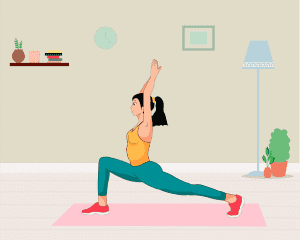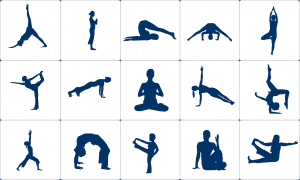1. Find a suitable workout space

Designate a corner in your home as your workout spot. Even if you just have the space for a yoga mat, that is still enough for an effective workout. Make sure there is nothing on the floor around you. Put your arms up and out to the sides and do a 360 – degree spin. Look for anything that could get in the way and cause you to trip, fall or an object that could be knocked over during your workout.
2. Put on your gym clothes
Dress like you’re going to the gym. You will feel more like exercising when you’re wearing athletic clothes and footwear. For example, if you’re running on a treadmill, wear running shoes.
3. Warm up, stretch & cool down
When working out at home be sure to warm up and stretch just like you would in the gym or sprawl area. Progress from smaller to large, full scale movements. Smaller movements are low impact, low intensity such as walking, marching on the spot or jogging. When warming up, incorporate *dynamic stretching. Dynamic stretching is conducted from a standing position, where the end point of the stretch is not held*. Examples include lunge with a twist, knee to chest etc. Try to warm up for 10 minutes, so you can prevent muscle strain and injury.
When your workout is over, be sure to cool down just like you would in a fitness class or gym workout. Cooling down helps to flush the lactic acid out of your system and prevent muscle soreness. After you have cooled down, stretch using *static stretching. Static stretching involves stationary, controlling stretching where you move slowly into a position for a typical duration of 15- 30 seconds. Examples of static stretching are a calf stretch, quadriceps stretch, hamstring stretch etc.
4. Cross Train
Doing just one type of exercise every day can put strain on a particular muscle group, which can increase the probability of injury. To combat this, mix it up with different kinds of exercises so that you don’t overexert certain muscles.
5. Listen to Your Body

Exercising can be intense and can create discomfort, however pain is not necessary for a workout to be successful. In fact, pain when working out could be a danger sign of muscle exhaustion or even a torn ligament You might feel compelled to push through the pain while exercising, you should always listen to your body. It will thank you.
6. Know your limits
When you’re working out at home, you maybe without a spotter. For this reason, its very important to know your limits, especially if you’re lifting weights. Consult with a personal trainer to help determine the amount of weight you can safely lift and apply this to your home workout routine.
The same rules apply for cardio exercises as well. Don’t run faster or longer if you can’t safely. Try the ‘talk test’ which is a proven source of monitoring exercise intensity. Consult with a personal trainer to determine what cardio routine is best and safest for you
7. Rest: quality, not quantity
According to Jeff Bercovici, the author of Play On: The New Science of Elite Performance at Any Age, in his research for the book he found that “the most successful athletes today are not the ones who workout the hardest but the ones who avoid the insidious buildup of fatigue. They’re the ones who recognize the difference between beneficial and harmful training stress and adopt methods that maximize the former and minimize the later. ‘Work smarter, not harder’ have replaced ‘No pain, no gain’ as the motivational slogans on the walls of pro sports weight rooms”.
8. Have fun with it
No matter what type exercise your doing, have fun with it, be present and enjoy the movements. Do an online zoom fitness class with your classmates or colleagues. BCIT recreation services offers free virtual fitness classes to BCIT students and staff! Check out our virtual fitness class schedule for details on how to register.
